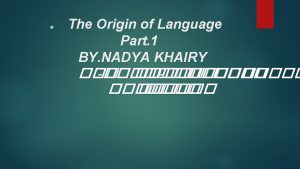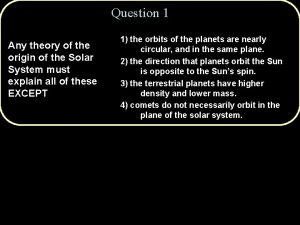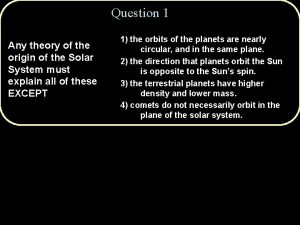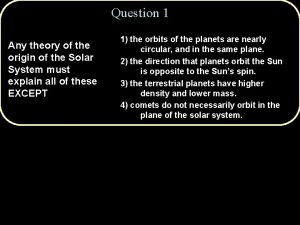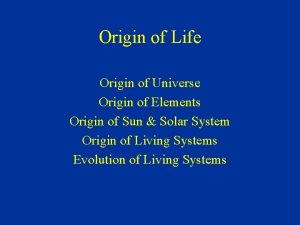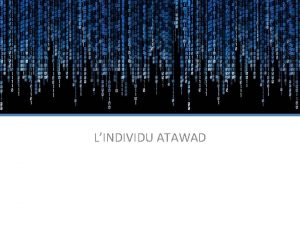Question 1 Any theory of the origin of
















- Slides: 16

Question 1 Any theory of the origin of the Solar System must explain all of these EXCEPT 1) the orbits of the planets are nearly circular, and in the same plane. 2) the direction that planets orbit the Sun is opposite to the Sun’s spin. 3) the terrestrial planets have higher density and lower mass. 4) comets do not necessarily orbit in the plane of the solar system.

Question 1 Any theory of the origin of the Solar System must explain all of these EXCEPT 1) the orbits of the planets are nearly circular, and in the same plane. 2) the direction that planets orbit the Sun is opposite to the Sun’s spin. 3) the terrestrial planets have higher density and lower mass. 4) comets do not necessarily orbit in the plane of the solar system. The planets do orbit in the same direction that the Sun spins. Most also spin in that direction, and most also have large moons that orbit in that direction.

Question 2 What is the name of theory that is currently used to describe the formation of the solar system? 1) Perturbation Theory 2) Condensation Theory 3) Differentiation Theory 4) Close-encounter Theory

Question 2 What is the name of theory that is currently used to describe the formation of the solar system? 1) Perturbation Theory 2) Condensation Theory 3) Differentiation Theory 4) Close-encounter Theory

Question 3 The condensation sequence theory explains why 1) our planet Earth has water and rain. 2) stars are more likely to form large planets orbiting very near. 3) terrestrial planets are different from jovian planets. 4) the Moon formed near the Earth. 5) Pluto has such a circular orbit.

Question 3 The condensation sequence theory explains why 1) our planet Earth has water and rain. 2) stars are more likely to form large planets orbiting very near. 3) terrestrial planets are different from jovian planets. 4) the Moon formed near to Earth. 5) Pluto has such a circular orbit. The condensation sequence theory explains how the temperature of the early solar nebula controls which materials are solid, and which are gaseous.

Question 4 With rapid collapse from icy planetesimals, the ____ theory would have the jovians growing quickly into giants. 1) large impact 2) core-accretion 3) gravitational instability 4) perturbation 5) Oort Cloud

Question 4 With rapid collapse from icy planetesimals, the ____ theory would have the jovians growing quickly into giants. 1) large impact 2) core-accretion 3) gravitational instability 4) perturbation 5) Oort Cloud

Question 5 Why did a major planet not form out in the Kuiper Belt? 1) One did, and its name is Pluto. 2) Some may have, but they have since migrated to orbits nearer the Sun. 3) Sedna disrupted objects closer to the Sun. 4) Comets bombarded these bodies violently, breaking them apart. 5) It was not in the ecliptic like the planets; there was no material out there.

Question 5 Why did a major planet not form out in the Kuiper Belt? 1) One did, and its name is Pluto. 2) Some may have, but they have since migrated to orbits nearer the Sun. 3) Sedna disrupted objects closer to the Sun. 4) Comets bombarded these bodies violently, breaking them apart. 5) It was not in the ecliptic like the planets; there was no material out there.

Question 6 Astronomers have detected most extrasolar planets by observing 1) the “wobble” of their parent stars using spectroscopy. 2) starlight reflected by their surfaces. 3) eclipses when the planets block the light of their parent stars. 4) the planets’ changing phases as they orbit their stars.

Question 6 Astronomers have detected most extrasolar planets by observing 1) the “wobble” of their parent stars using spectroscopy. 2) starlight reflected by their surfaces. 3) eclipses when the planets block the light of their parent stars. 4) the planets’ changing phases as they orbit their stars. Measurements of the periodic Doppler Shift in the spectra of the star 51 Pegasi indicate it has a planetary companion.

Question 7 Beyond our own solar system, the planets found to date have tended to be 1) Kuiper Belt Objects, far from the glare of their suns. 2) large jovians far from stars like our Sun 3) large jovians with orbits more like terrestrial planets. 4) terrestrials very close to their star, and transiting its disk. 5) imaginary, with no present proof that they really exist.

Question 7 Beyond our own solar system, the planets found to date have tended to be 1) Kuiper Belt Objects, far from the glare of their suns. 2) large jovians far from stars like our Sun 3) large jovians with orbits more like terrestrial planets. 4) terrestrials very close to their star, and transiting its disk. 5) imaginary, with no present proof that they really exist. As of spring 2007, more than 200 extrasolar planets have been detected orbiting some 180 stars within a few hundred light-years of the Sun.

Question 8 Extrasolar planets the size of Earth have NOT been seen yet with current techniques because 1) small planets probably don’t exist. 2) the large planets nearby have swept them up. 3) Earth-like planets take time to form. 4) large planets orbiting near to their stars are more easily detected. 5) small planets can only be seen if they cross in front of their star.

Question 8 Extrasolar planets the size of Earth have NOT been seen yet with current techniques because 1) small planets probably don’t exist. 2) the large planets nearby have swept them up. 3) Earth-like planets take time to form. 4) large planets orbiting near to their stars are more easily detected. 5) small planets can only be seen if they cross in front of their star. Looking for detectable “wobbles” in the spectra of stars finds massive planets with small orbits. Other techniques may be needed to see less massive Earth-like planets.
 Any question atau any questions
Any question atau any questions Costas question
Costas question There is there are
There is there are Any to any connectivity
Any to any connectivity Question tags definition
Question tags definition Hypernates
Hypernates Any question slide
Any question slide Thank you for your attention if you have any questions
Thank you for your attention if you have any questions Question without question words
Question without question words Highly closed question
Highly closed question Contoh open ended question adalah
Contoh open ended question adalah What do you call the factor-naming questions?
What do you call the factor-naming questions? Direct question
Direct question Example of a compelling question
Example of a compelling question Compelling question definition
Compelling question definition Source of language
Source of language Graph theory history
Graph theory history















